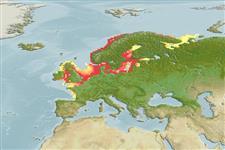分类 / Names
俗名 | 同种异名 | Catalog of Fishes(属, 种) | ITIS | CoL | WoRMS | Cloffa
Teleostei >
Osmeriformes (Freshwater smelts) >
Osmeridae (Smelts)
Etymology: Osmerus: Greek, osme = odorous; similar to freshly cut cucumbers (Ref. 45335).
More on author: Linnaeus.
Environment: milieu / climate zone / depth range / distribution range
生态学
海洋; 淡水; 半咸淡水; 溯河洄游 (Ref. 51243), usually ? - 50 m (Ref. 4545). 溫帶; 70°N - 43°N, 9°W - 55°E
North Atlantic: White Sea southward to western coasts of France including Baltic Sea, southern North Sea and British Isles (Ref. 4545); the Gironde estuary is the southern limit of his distribution (Ref. 51442). Landlocked populations in lakes of coastal areas of North, Baltic, White and Barents Sea. North to about 68° N in Scandinavia (Ref. 59043). The former nominal subspecies Osmerus eperlanus eperlanus is recorded from the coasts and drainage of White and Barents Seas westward through Baltic Sea to Denmark and it is primarily lacustrine (Ref. 4545). The former subspecies Osmerus eperlanus schonfoldi (Rutty 1772) is sympatric with the nominate subspecies in parts of Poland, Denmark and the Baltic, and it is primarily anadromous (Ref. 4545).
北大西洋: 白海向南至法國包括波羅的海,北海南部與英國島的西海岸;(參考文獻 4545) 法國革命時期的穩健共和黨河口是他的分布的南方限制。 (參考文獻 51442) 對丹麥,先前的名義上的亞種 Osmerus eperlanus eperlanus 距離海岸被記錄與經過波羅的海向西白色的流域與巴倫支海,而且它主要湖泊。 (參考文獻 4545) 前亞種 Osmerus eperlanus schonfoldi(遍地轍痕的 1772) 重疊分佈那在波蘭的部份, 丹麥與波羅的海中提名的亞種, 與它主要溯河洄游產卵.(參考文獻 4545)
Length at first maturity / 大小 / 重量 / 年龄
Maturity: Lm 12.8 range ? - ? cm
Max length : 45.0 cm TL 雄鱼/尚未辨别雌雄; (Ref. 4545); common length : 16.5 cm TL 雄鱼/尚未辨别雌雄; (Ref. 682); 最大体重: 178.00 g (Ref. 6114); 最大年龄: 10 年 (Ref. 682)
背棘 (总数): 0; 背的软条 (总数): 9-12; 臀棘 0; 臀鳍软条: 12 - 16; 脊椎骨: 55 - 62. Body long and slim (Ref. 4545). Head rather pointed (Ref. 4545). Snout pointed (Ref. 4545). Upper jaw reaching to hind margin of eye, lower jaw projecting a little (Ref. 4545, Ref. 51442). Teeth in lower jaw larger than those of upper, strong teeth on tongue and canines on vomer (Ref. 4545). Dorsal fin origin behind base of pelvic fins (Ref. 4545). Incomplete lateral line is developed near the head (Ref. 51442). Dorsal side light olive green, flanks silver stripe, belly creamy white (Ref. 4545).
身体长而瘦的.(参考文献 4545) 头部相当尖.(参考文献 4545) 吻端尖的.(参考文献 4545) 上颌延伸到眼的后缘,下颌突出的稍微.(参考文献 4545, 参考文献 51442) 在下颌的齿大于那些上面的, 强劲地在犁骨上牙齿在舌与犬齿.(参考文献 4545) 在腹鳍基底后面的背鳍起点.(参考文献 4545) 不完全的侧线在头部的附近被发展。 (参考文献 51442) 背部两侧淡的橄榄绿色的, 侧面银色的斑纹, 腹面乳脂色的白色.(参考文献 4545)
Inhabits marine waters, estuaries and large lakes (Ref. 59043). A midwater species, rarely far from shore, primarily anadromous in the west and lacustrine in the east; shoaling at least during spawning season (Ref. 4545). The essential part of its life is spend in the estuarine zone, with just short incursions in the littoral zone (Ref. 51442). The migratory form is grouping together in the estuarine zone for reproduction (Ref. 51442). Enters the rivers for spawning on sandy or gravely bottoms (Ref. 13696). Spawns in tributaries of lakes or along shallow shores of lakes and rivers on sand, gravel, stones and plant material, preferably in fast-flowing water (Ref. 59043). Reproduction takes place between February and May, depending on the water-temperature (Ref. 51442). Produces 8,000-50,000 yellow eggs with a diameter of 0.6-0.9 mm which adhere to the bottom (Ref. 13696, Ref. 51442). Eggs hatch in 3-5 weeks and the larvae descend to the estuarine zone (Ref. 13696, Ref. 51442). Feeds on shrimps and small crustaceans; larger individuals feed on small fish (Ref. 30578, Ref. 51442). Utilized as foodfish, smoked, as bait and fish oil (Ref. 35388). Smells like cucumber (Ref. 37032, 51442). Locally threatened due to pollution and barriers to migration (Ref. 59043).
一个中层水域种,很少地远离海岸, 主要溯河洄游产卵在东部中的西方与湖泊者中; 在产卵季节的时候群集的至少。 (参考文献 4545) 他的生活的必要部份是在河口的区域中度过, 在海滨的区域中的仅仅短的侵入.(参考文献 51442) 回游的形式对于繁殖在河口的区域中一起是配列。 (参考文献 51442) 它进入河进行产卵沙的之上或者严重地底部.(参考文献 13696) 繁殖在二月之间发生与五月, 依据水温而定.(参考文献 51442) 它生产 8,000-50,000 黄色卵有黏附在底部的 0.6-0.9 mm 的直径.(参考文献 13696, 参考文献 51442) 他们在 3-5个星期中孵化,而且仔鱼下降到河口的区域。 (参考文献 13696, 参考文献 51442) 吃虾与小型甲壳动物; 较大的个体吃小鱼。 (参考文献 30578, 参考文献 51442) 他们在 3-4 年 (15-18 公分) 中在半咸淡的族群性成熟了, 在淡水中的 1-2 年 (810 公分的)。 用来作食用鱼,烟熏了, 如诱饵与鱼油。 (参考文献 35388) 闻相似的黄瓜。 (参考文献 37032, 参考文献 51442)
Life cycle and mating behavior
成熟度 | 繁殖 | 产卵场 | 卵 | 孕卵数 | 仔鱼
Spawns in lower reaches of streams, deeper parts of lake in sand bottoms (Ref. 682). Spawning takes place with the melting of snow (Ref. 682). Many individuals die after the spawning (Ref. 682). Migratory form generally with rapid growth, more eggs, live longer; individuals feeding on fish grow bigger (Ref. 682). ). Becomes sexually mature in 3-4 years (15-18 cm) in brackish populations, 1-2 years (8-10 cm) in freshwater.北大西洋: 白海向南至法國包括波羅的海,北海南部與英國島的西海岸;(參考文獻 4545) 法國革命時期的穩健共和黨河口是他的分布的南方限制。 (參考文獻 51442) 對丹麥,先前的名義上的亞種 Osmerus eperlanus eperlanus 距離海岸被記錄與經過波羅的海向西白色的流域與巴倫支海,而且它主要湖泊。 (參考文獻 4545) 前亞種 Osmerus eperlanus schonfoldi(遍地轍痕的 1772) 重疊分佈那在波蘭的部份, 丹麥與波羅的海中提名的亞種, 與它主要溯河洄游產卵.(參考文獻 4545)
Kottelat, M. and J. Freyhof, 2007. Handbook of European freshwater fishes. Publications Kottelat, Cornol and Freyhof, Berlin. 646 pp. (Ref. 59043)
人类利用
渔业: 商业性
更多信息
合作者照片Stamps, Coins Misc.声音神经毒速度泳型鳃区Otoliths脑重体重比眼睛色素
工具
特别资料
下载 XML
网络资源
Estimates based on models
Preferred temperature (Ref.
123201): 5.5 - 12, mean 9.6 °C (based on 1010 cells).
Phylogenetic diversity index (Ref.
82804): PD
50 = 0.5625 [Uniqueness, from 0.5 = low to 2.0 = high].
Bayesian length-weight: a=0.00417 (0.00269 - 0.00646), b=3.18 (3.05 - 3.31), in cm total length, based on LWR estimates for this species & (Sub)family-body (Ref.
93245).
营养阶层 (Ref.
69278): 3.5 ±0.42 se; based on food items.
回复力 (Ref.
120179): 中等的, 族群倍增时间最少 1.4 - 4.4年 (K=0.15-0.25; tm=2-4; tmax=10; Fec=10,000).
Fishing Vulnerability (Ref.
59153): Moderate vulnerability (43 of 100).
Climate Vulnerability (Ref.
125649): High to very high vulnerability (72 of 100).
Nutrients (Ref.
124155): Calcium = 43.2 [16.7, 100.8] mg/100g; Iron = 0.467 [0.228, 1.197] mg/100g; Protein = 17.5 [14.5, 20.0] %; Omega3 = 0.804 [0.404, 1.637] g/100g; Selenium = 13.8 [6.4, 30.4] μg/100g; VitaminA = 25.1 [9.0, 74.9] μg/100g; Zinc = 0.704 [0.457, 1.105] mg/100g (wet weight);
